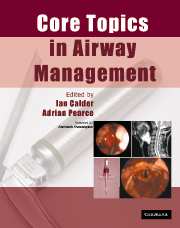Book contents
- Frontmatter
- Contents
- List of contributors
- Preface
- Acknowledgements
- List of abbreviations
- 1 Anatomy
- 2 Physiology of apnoea and hypoxia
- 3 Physics and physiology
- 4 Cleaning and disinfection of airway equipment
- 5 General principles
- 6 Maintenance of the airway during anaesthesia: supra-glottic devices
- 7 Tracheal tubes
- 8 Tracheal intubation of the adult patient
- 9 Confirmation of tracheal intubation
- 10 Extubation
- 11 Light-guided intubation: the trachlight
- 12 Fibreoptic intubation
- 13 Retrograde intubation
- 14 Endobronchial and double-lumen tubes, bronchial blockers
- 15 ‘Difficult airways’: causation and prediction
- 16 The paediatric airway
- 17 Obstructive sleep apnoea and anaesthesia
- 18 The airway in cervical trauma
- 19 The airway in cervical spine disease and surgery
- 20 The aspiration problem
- 21 The lost airway
- 22 Trauma to the airway
- 23 Airway mortality associated with anaesthesia and medico-legal aspects
- 24 ENT and maxillofacial surgery
- 25 Airway management in the ICU
- 26 The airway in obstetrics
- Index
12 - Fibreoptic intubation
Published online by Cambridge University Press: 15 December 2009
- Frontmatter
- Contents
- List of contributors
- Preface
- Acknowledgements
- List of abbreviations
- 1 Anatomy
- 2 Physiology of apnoea and hypoxia
- 3 Physics and physiology
- 4 Cleaning and disinfection of airway equipment
- 5 General principles
- 6 Maintenance of the airway during anaesthesia: supra-glottic devices
- 7 Tracheal tubes
- 8 Tracheal intubation of the adult patient
- 9 Confirmation of tracheal intubation
- 10 Extubation
- 11 Light-guided intubation: the trachlight
- 12 Fibreoptic intubation
- 13 Retrograde intubation
- 14 Endobronchial and double-lumen tubes, bronchial blockers
- 15 ‘Difficult airways’: causation and prediction
- 16 The paediatric airway
- 17 Obstructive sleep apnoea and anaesthesia
- 18 The airway in cervical trauma
- 19 The airway in cervical spine disease and surgery
- 20 The aspiration problem
- 21 The lost airway
- 22 Trauma to the airway
- 23 Airway mortality associated with anaesthesia and medico-legal aspects
- 24 ENT and maxillofacial surgery
- 25 Airway management in the ICU
- 26 The airway in obstetrics
- Index
Summary
Dr Peter Murphy (Figure 12.1) was the first to use a flexible endoscope ('scope) to intubate the trachea, while a Registrar at the National Hospital, Queen Square in 1967. He moved to Chicago shortly afterwards, where he still practises.
Flexible fibreoptic intubation is a tremendously useful technique, which every anaesthetist should attempt to master. The advantage of vision, the pre-eminent sense, needs no explanation.
Fibreoptic laryngoscopy is easier in the awake patient. The less experienced you are, the more inclined to an ‘awake’ procedure you should be.
Flexible fibreoptic intubation is not a panaceabecause of the following:
It is relatively slow, not suitable for really rapid airway management.
Blood and secretions can easily prevent vision.
An air space is required, which may be absent when there is soft tissue swelling.
It can be impossible to access a glottis displaced from the midline.
Blind techniques have succeeded when flexible fibreoptics have failed.
How to do it
Make sure the equipment is correct
a Use a television (TV) camera and screen if possible (a bigger view and helpful for assistants).
b Adjust the focus and orientation of the camera.
c Use a mains-powered light source if possible, although battery-powered ones are adequate.
d The easiest tracheal tube to pass off a flexible laryngoscope is the silicone intubating laryngeal mask airway (silicone ILMA) tube, followed by the ‘Flexilum’-reinforced tube (Mallinkrodt). Ordinary tubes can be used but do not pass as easily.
e Wind the pilot tube round the tube and fix (loosely) with tape.
f Use the smallest size of tube you can; 6mm for women and 7mm for men is usual.
- Type
- Chapter
- Information
- Core Topics in Airway Management , pp. 97 - 104Publisher: Cambridge University PressPrint publication year: 2005

